Where did we come from?
A History of Informatics at TU Wien.
Werner Purgathofer, former professor at TU Wien Informatics and founder of VRVis, gives insights into the birth of our faculty from 1954 to 2004.

Picture: TU Wien
The Roots
The roots of informatics lie in electrical engineering and mathematics. As early as 1954, the mathematician Rudolf Inzinger founded the “Mathematical Laboratory” at the then Vienna Institute of Technology (Technische Hochschule Wien, TH) as a teaching and service center. Initially equipped with electronic office machines, the first computer, an IBM 650, was purchased in 1958. From 1955, the bold and rather future-oriented two-year university course “Modern Computing Technology” was held under the direction of the Mathematical Laboratory, in which the technical basics of computer use were also taught.

Picture: Musée de l’informatique / Wikipedia
In 1955, computer pioneer Heinz Zemanek began building the first fully transistorized computer in continental Europe, the famous “Mailüfterl”, presented in 1958. In 1959, Richard Eier, Zemanek’s assistant and later Professor of Data Processing at the Faculty of Electrical Engineering, presented a search algorithm for mazes. And in 1964, Inzinger and Zemanek, who then was also head of the IBM Research Lab for Fundamentals of Computer Languages, were able to acquire an IBM 7040 mainframe computer for TH. It remained the most powerful computer in Austria until the end of the 1960s. Already at that time, TH’s Lecture Hall 5 was rededicated to install the IBM computer. Professor Gerhart Bruckmann, a renowned Austrian statistician, used it to carry out the world’s first live TV electronic election prediction in 1966. Between 1967 and 1969, the Mathematical Laboratory became the Digital Computing Center of TH, directed by Hans Jörg Stetter, who was appointed Professor of Numerical Mathematics in 1965.
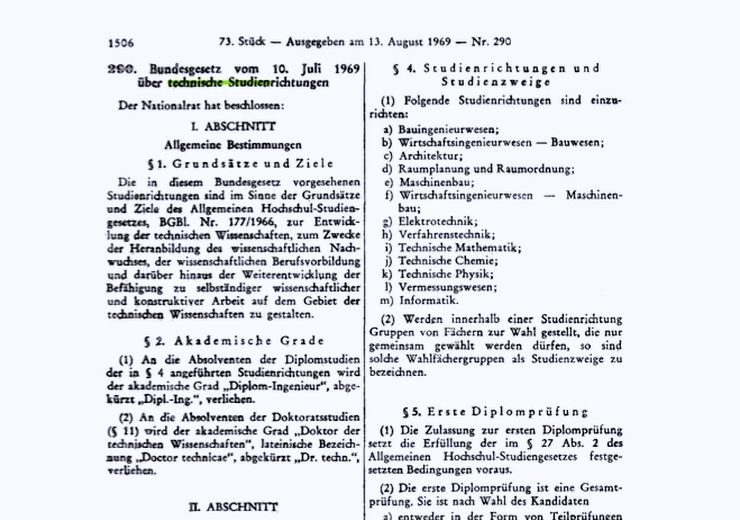
Picture: Bundeskanzleramt Österreich / ris.bka.gv.at
The Law that Changed the Game
In 1969, the growing importance of computer science led to widespread discussions in German-speaking countries about introducing computer science as a new study program, to be called informatics. As we know, Austria’s legal system is not the fastest to process this kind of challenge. However, out of pure coincidence, the Federal Law on Technical Studies (Bundesgesetz über technische Studienrichtungen) happened to be reformed in this spring of 1969. Of course, informatics had not yet been considered in the lengthy preparations for this update, so it was not included in the act. However, the then Federal Chancellor of Austria, Josef Klaus, had already been introduced to the world of digital electronic data processing in private lessons by Heinz Zemanek.
Only two weeks before the act was passed, a reception was organized – including Hans Jörg Stetter – who was well informed about the efforts to introduce IT at universities in Germany. On the way to the reception, Zemanek advised Stetter to talk to the Federal Chancellor about these efforts. Chancellor Klaus acted promptly: he immediately called in an assistant and instructed him to work with Stetter to insert adequate additions to the legal text. Without legal knowledge, Stetter completed this task the following night – using a mechanical typewriter, of course – and sent it to his partner the next day. This text was adopted as an own-initiative motion by the Austrian People’s Party (ÖVP) at the next committee meeting without a dissenting vote.
Austria is a hopeless case, but miracles have a positive expectation value!
At TH Wien, Rudolf Inzinger recognized the opportunity of the hour. He could have criticized the actions of his colleagues and the party for ignoring responsible university committees, but instead, he wrote a positive statement from TH on introducing a computer science course, as requested by the ministry. On July 10, 1969, the act was passed in the national council. Hans Jörg Stetter then coined his famous statement: “Austria is a hopeless case, but miracles have a positive expectation value!”. For the sake of completeness, it must be added here that further preparatory work and interventions also contributed to the success of this spontaneous campaign, above all by Wilhelm Barth (Vienna) and Adolf Adam (Linz).
The First Representative of “Informatics” in Vienna, Helmut Schauer
Helmut Schauer studied electrical engineering at TH Wien from 1961. His interest in computers was particularly stimulated by Professor Zemanek’s lecture “Boolean Algebra”, and Schauer was the first graduate in electrical engineering who didn’t build a physical device for his diploma – his thesis was “only” a program about digital filters. He learned programming (in ALGOL-60) during his studies under Werner Baron at Hans Jörg Stetter’s institute. As early as 1966, the first recursive programs for solving chess problems were created on the IBM 7040.
From 1967, Schauer worked as a graduate assistant (Studienassistent) for Hans Jörg Stetter and became his assistant at the Institute for Numerical Mathematics after completing his studies in 1968. At that time, it was customary for an assistant to attend all of his professor’s lectures. Further assistants of Stetter in those years were Dieter Schornböck, Werner Baron, Hildegard Sochatzy, Christoph Überhuber, Jörg Hertling, Friedrich Firneis, and W. Riha. In addition to numerical mathematics, the institute also supervised all informatics courses.
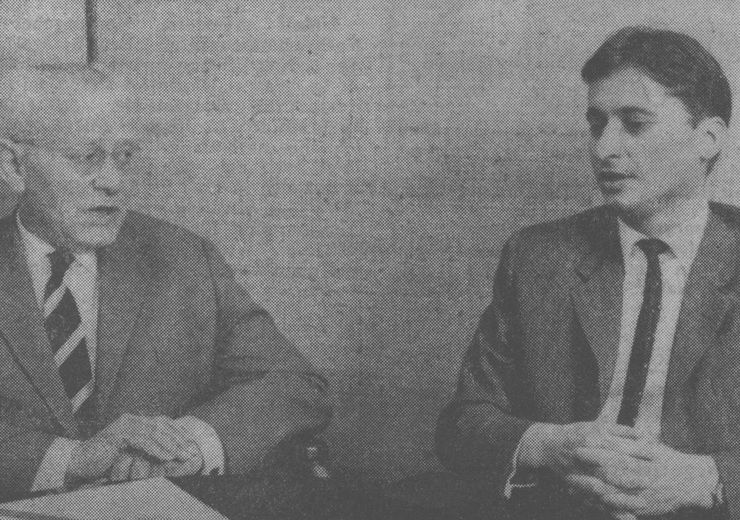
Picture: TU Wien Archiv
Professor Stetter spent the academic year 1969/70 in the USA, and Wilhelm Barth from Darmstadt was engaged as a substitute for the Chair of Numerical Mathematics. Together with Stetter’s assistant Helmut Schauer, the first computer science courses were held during this time: Introduction to Computer Science, Introductory Practical Programming (in ALGOL-60 with punch cards in Lecture Hall 5). When Stetter returned, he relinquished the computer science part and returned to numerical mathematics, which came as a surprise to everyone. As Barth’s one year engagement was also over, Schauer represented informatics for a couple of years, until the first professors of informatics were assigned. He held all basic computer science courses and was seen as “Mr. Informatics” at that time. A few years later, Schauer completed his doctorate on hash tables.
A Decade of Stagnation, and Finally the Expansion of Informatics
From 1970, the Social Democratic Party (SPÖ) under Bruno Kreisky formed the government, which initially provided strong support for sciences in general. A separate Ministry of Science was established under Hertha Firnberg, and generous funding was provided to expand universities. Together with the Linz Institute of Social and Economic Sciences (Hochschule für Sozial- und Wirtschaftswissenschaften Linz), TH Wien agreed to define and introduce an Informatics degree program in 1970. In 1971, mathematician Werner Kuich was appointed professor of Mathematical Logic and Formal Languages, in 1972 Manfred Brockhaus became the first pure informatics professor for Information Technology, followed by Wilhelm Barth for Information Systems in 1973 and Helmut Kerner for Digital Systems in 1974.
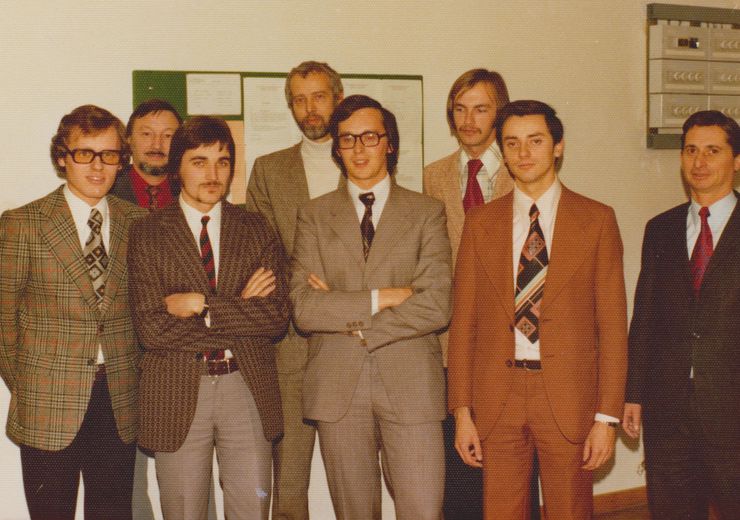
Picture: W. Purgathofer
Most of them were assigned to the Faculty of Natural Sciences; only Barth joined the former Faculty of Mechanical and Electrical Engineering. Some of the assistants in the early years were Cornel Pokorny, Georg Barta, Ada Szer, Rupert Nagler (all with Barth), Paul Tavolato, Gudrun Vincena, Wolfgang Laun (all with Brockhaus), Roland Mittermeir (with Kerner).
The Higher Education Organisation Act of 1975 changed the university structure: TH Wien was renamed to TU Wien (literal translation: Technical University of Vienna), and all informatics professors and institutes were assigned to the renamed Faculty of Engineering and Natural Sciences (TNF). Furthermore, faculties were organized in sections - creating also the Informatics Section (Fachgruppe Informatik), the professorial council was abolished as the most important decision-making body, and the representative participation of all academic staff and of students was introduced. Unfortunately, the expansion also ended; apart from the number of students, hardly anything increased. In 1980, the Informatics Section still had only three professors (Brockhaus, Barth, Kerner) and 12 assistants – Kuich was assigned to the Mathematics Section.
Informatics students and teachers started fighting for resources. “We needed computers and had none. We needed rooms but had nowhere to go. And we needed more people in informatics but were scarcely funded”, Helmut Schauer recalls the dire circumstances. The informatics student organization (Fachschaft Informatik) took action, leading to weekly demonstrations and the occupation of the Porrhaus (now Campus Treitlstraße, then owned by the Austrian Union ÖGB) and the Funkhaus Argentinierstraße, City HQ of the Austrian Broadcasting Cooperation (ORF), and with student strikes for several weeks. This induced massive media attention, which finally led to a political reaction – in 1986, the Porrhaus was fully assigned to informatics, and new professorships and appointments followed.
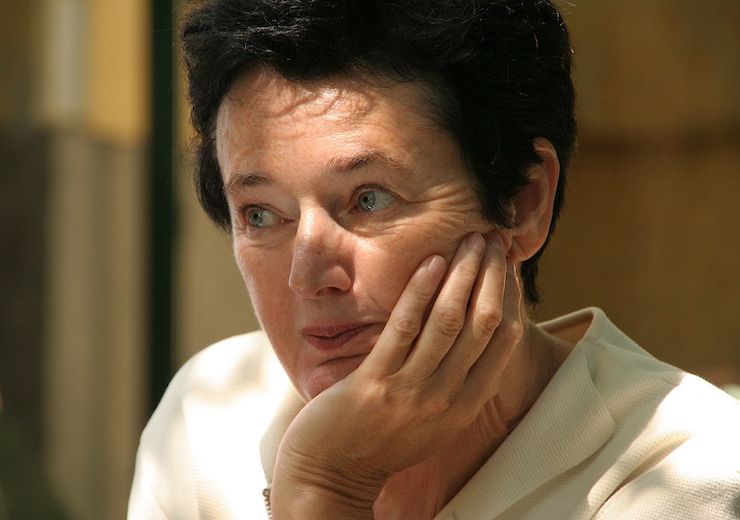
Picture: Ina Wagner
One of the new appointments was the first female professor for informatics in Austria, Ina Wagner, in 1987. She focused on Multidisciplinary System Design and headed the Institute for Design and Impact Research at TU Wien from 1987 until her retirement in 2011.
From ‘Fachgruppe’ to Faculty
In the 1990s, there was still no stand-alone organizational department for informatics in the university structure, although the study programs had long been established.
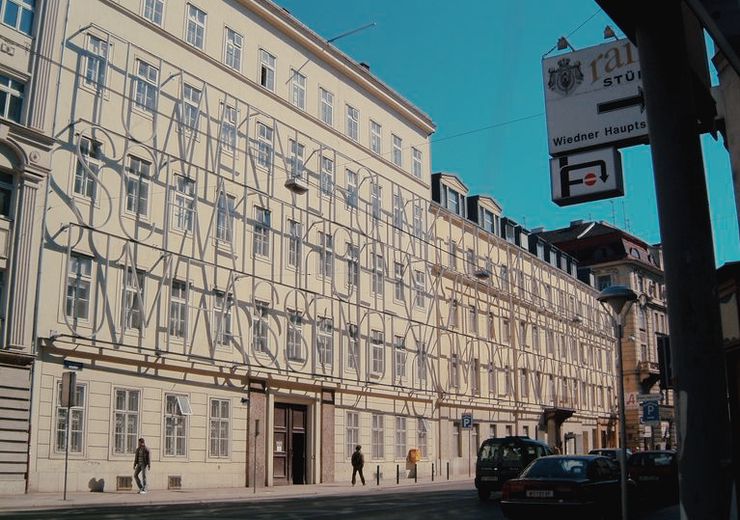
Picture: TU Wien
The informatics institutes and research labs were distributed over 8 buildings (Karlsplatz 13, Resselgasse 3, Argentinierstraße 8, Treitlstraße 3, Paniglgasse 16, Gusshausstraße 30, Gumpendorferstraße 6, Möllwaldplatz 4-5), up to 20 minutes walk apart from each other. The number of students and incoming researchers rose continuously, and when TU Wien acquired the building at Favoritenstraße 9-11 in 1996, the Informatics Section (Fachgruppe Informatik) was able to convince the university management, that a concentration of informatics at this address was the best solution. Yet, the additional 11.000 sqm eventually proved insufficient for the department’s spatial demands in 1999 (after the building had been renovated), and the premises in Treitlstraße and Argentinierstraße had to be kept, contrary to the department’s aim of bringing all its units together in one place.
After decades of calling for a Faculty of Informatics, the 2002 University Act provided the legal and organizational framework to formally establish the “Fakultät für Informatik” (TU Wien Informatics) on 1 January, 2004. Gerald Steinhardt served as the first dean until 2015, followed by Hannes Werthner from 2016 to 2019, and Gerti Kappel since 2020.
Of course, our story doesn’t end here – it has only just begun.
Read more in part two “Where did we go? Charting the path of an Informatics Faculty.”
Large parts of this article are based on interviews conducted in 2014 with Professors Hans Stetter, Wilhelm Barth, and Helmut Schauer, supplemented by archive research.

